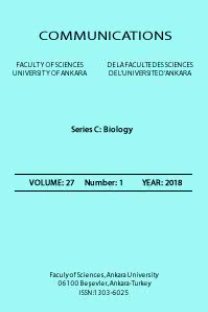CHEMOTAXONOMY IN BACTERIAL SYSTEMATICS
Bacteria, Phylogenetic systematic, Chemotaxonomy
___
M.Goodfellow and A.G O' Donnell, Chemical Methods in Prokaryotic Systematics, John Wiley and Sons, Chichester, 1994.M. Goodfellow and D.E Minnikin, Chemical Methods in Bacterial Systematics, Society for Applied Bacteriology, Technical Series No: 20, Academic Press, London and New York, 1985.
E. Stackebrandt and M. Goodfellow (Editors), Nucleic Acid Techniques in Bacterial Systematics, Journal of Basic Microbiology, 31 (6), (1991) 479-480.
I. Yamashita, M.Nakamura and S. Fukui, Gene fusion is a possible mechanism underlying the evolution of STA1, Journal of Bacteriology, 169 (5), (1987) 2142-2149.
K.H. Schleifer and O. Kandler, Peptidoglycan types of bacterial cell walls and their taxonomic implication, Microbiology and Molecular Biology Reviews, 36 (4), (1972) 407. [6] A.M. Glauert and M.J. Thornley, The topography of the bacterial cell wall, Annual Reviews in Microbiology, 23 (1), (1969) 159-198.
M.P. Lechevalier and H.A. Lechevalier, Chemical composition as a criterion in the classification of actinomycetes, International Journal of Systematic Bacteriology, 20, (1970b) 435-443.
M. Leyh-Bouille, R. Bonaly, J.M. Ghuysen, R. Tinelli, D. Tipper, LL-diaminopimelic acid containing peptidoglycans in walls of Streptomyces sp. and of Clostridium perfringens (type A), Biochemistry, 21 (15), (1970) 2944–2952.
M.P. Lechevalier and H. Lechevalier, Chemical composition as a criterion in the classification of aerobic actinomycetes, International Journal of Systematic and Evolutionary Microbiology, 20 (4), (1970) 435-443.
J. Baddiley, Teichoic acids and the molecular structure of bacterial walls, The Leeuwenhoek lecture Proc R Soc Lond B Biol Sci, 170 (1021), (1967) 331–348.
J. Baddiley, J.G. Buchanan, F.E. Hardy, R.O. Martin, U.L. Rajbhandary, A.R. Sanderson, The structure of the ribitol teichoic acid of Staphylococcus aureus, Biochimica et Biophysica Acta, 52, (1961) 406–407.
J.J. Armstrong, J. Baddiley, J.G. Buchanan, Further studies on the teichoic acid from Bacillus subtilis walls, Biochemical Journal, 80, (1961) 254–261.
J. Baddiley, J.G. Buchanan, U.L. Rajbhandary, A.R. Sanderson, Teichoic acid from the walls of Staphylococcus aureus structure of the N-acetylglucosaminyl-ribitol residues, Biochemical Journal, 82, (1962) 439–448.
F. Kanetsuna, T. Imaeda, G. Cunto, On the linkage between mycolic acid and arabinogalactan in phenol-treated myobacterial cell walls, Biochimica et Biophysica Acta, 173 (2), (1969) 341–344.
D.E. Minnikin, P.V. Patel, L. Alshamaony and M. Goodfellow, Polar lipid composition in the classification of Nocardia and related bacteria, International Journal of Systematic and Evolutionary Microbiology, 27 (2), (1977) 104-117.
N. Fujimoto, T. Kosaka and M. Yamada, Menaquinone as well as ubiquinone as a crucial component in the Escherichia coli respiratory chain, In Chemical Biology, InTech, (2012).
L. Jeffries, M.A. Cawthorne, M. Harris, B. Cook and A.T. Diplock, Menaquinone determination in the taxonomy of Micrococcaceae, Microbiology, 54 (3), (1968) 365-380.
K. Hamana and S. Matsuzaki, Polyamines as a chemotaxonomic marker in bacterial systematics, Critical Reviews in Microbiology, 18 (4), (1992) 261-283.
S. Yamamoto, K. Hamanaka, Y. Suemoto, B. Ono and S. Shinoda, Evidence for the presence of a novel biosynthetic pathway for norspermidine in Vibrio, Canadian Journal of Microbiology, 32, (1986) 99.
[Z. Zhang, Y. Wang and J. Ruan, Reclassification of Thermomonospora and Microtetraspora, International journal of systematic bacteriology , 48, (1998a) 411–422.
C. Dalmastri, L. Gastaldo, GL. Marcone, E. Binda, T. Congiu, F. Marinelli, Classification of Nonomuraea sp. ATCC 39727, an Actinomycete that produces the glycopeptide antibiotic A40926, as Nonomuraea gerenzanensis sp. nov., International Journal of Systematic and Evolutionary Microbiology, 66 (2), (2016) 912-921.
F.S. Gokdemir, Nonomuraea cinsine ait izolatların Multi gen dizi analizine dayalı filogenetik sistematiği, Yüksek Lisans Tezi, Ondokuz Mayıs Universitesi, Fen Bilimleri Enstitüsü, (2014).
R. Rosselló-Mora and R. Amann, The species concept for prokaryotes, FEMS Microbiology Reviews, 25 (1), (2001) 39-67.
P. Vandamme, B. Pot, M. Gillis, P. De Vos, K. Kersters & J. Swings, Polyphasic taxonomy, a consensus approach to bacterial systematics, Microbiology and Molecular Biology Reviews, 60 (2), (1996) 407-438.
M.P. Lechevalier and C.W. Moss, Lipids in bacterial taxonomy-a taxonomist's view, CRC Critical Reviews in Microbiology, 5 (2), (1977) 109-210.
E.A. Barka, P. Vatsa, L. Sanchez, N.Gaveau-Vaillant, C.Jacquard, H. Klenk, & G. P. Van Wezel, Taxonomy, physiology, and natural products of Actinobacteria, Microbiology and Molecular Biology Reviews, 80 (1), (2016) 1-43.
Y. Wang and Y. Jiang, Chemotaxonomy of actinobacteria, In Actinobacteria-Basics and Biotechnological Applications, IntechOpen, (2016).
- ISSN: 1303-6025
- Yayın Aralığı: Yılda 2 Sayı
- Başlangıç: 1943
- Yayıncı: Ankara Üniversitesi
METAL ACCUMULATION PROFILE IN CRAYFISH TISSUES FROM ÇOMAR STREAM
Seyda FIKIRDESICI-ERGEN, Hatice MUTLU-EYISON, Ahmet ALTINDAG
İlker BUYUK, Behcet INAL, Emre ILHAN, Sumer ARAS
THE PALYNOLOGICAL TRAITS OF FOUR ENDEMIC SILENE L. (CARYOPHYLLACEAE) SPECIES IN TURKEY
Burcu Yilmaz CITAK, Huseyin DURAL
FOUR NEW MICROFUNGI FOR TURKISH ASCOMYCOTA
Sanli KABAKTEPE, İlgaz AKATA, Mustafa SEVINDIK
EVALUATION OF THREAT CATEGORIES OF THE ENDEMIC PLANTS OF DEVECI MOUNTAINS (YOZGAT-TOKAT/TURKEY)
M. Umit BINGOL, Neslihan BALPINAR, Kerim GUNEY, Fatmagul GEVEN, Osman KETENOGLU, Munevver ARSLAN, Mehmet KARAKAS
GENERAL OVERVIEW OF THE STUDIES WITH MALDI-TOF
THREAT CATEGORIES OF ENDEMIC PLANTS OF SAKARAT MOUNTAIN (AMASYA/TURKEY)
M. Umit BINGOL, Neslihan BALPINAR, Kerim GUNEY, Arzu CANSARAN, Fatmagul GEVEN, Omer Faruk KAYA, Munevver ARSLAN
Kumbirai Deon MANDEBERE, F. Seyma GOKDEMIR, Gonul SOLMAZ, Sumer ARAS
HISTOMORPHOLOGICAL CHANGES ON THE TESTICULAR TISSUE IN DIABETIC RATS INDUCED WITH STREPTOZOTOCIN
Nihal SAÇMAOZU, Hatice MUTLU EYISON, Suna CEBESOY
